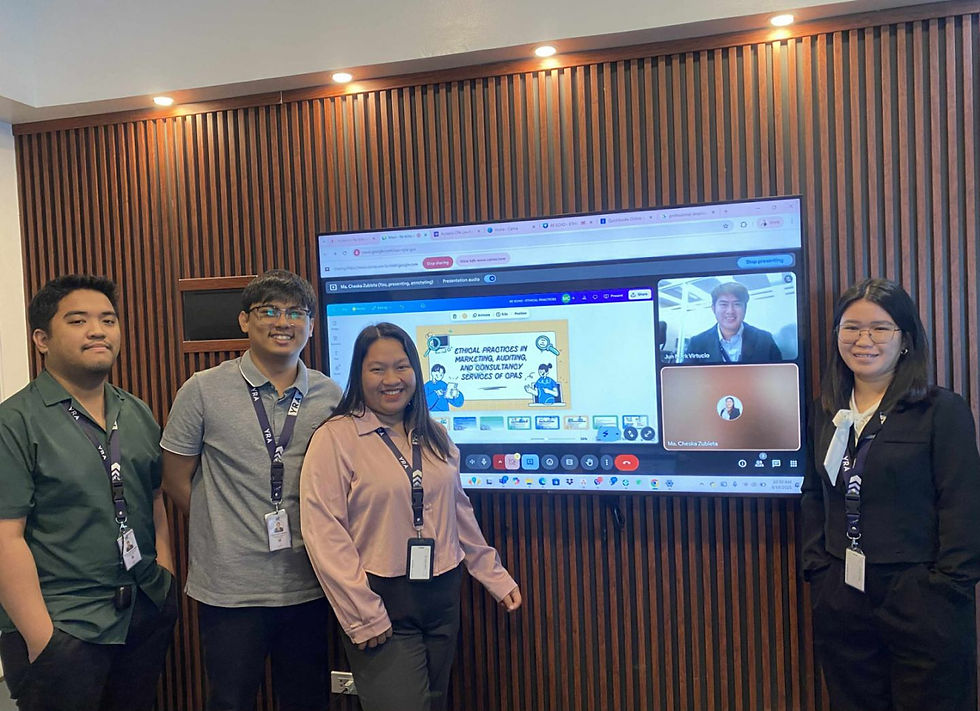Summary of “Common Issues and Remedies in the Financial Statements Audit of Small Entities”
- Atty. Yasser Aureada, CPA

- Oct 9
- 2 min read

Overview
The presentation outlines the key stages, challenges, and remedies in conducting financial statement audits for small entities. While the Philippine Standards on Auditing (PSAs) apply equally to all entities, their application in smaller, less complex environments requires practical adjustments.
1. Steps in the Audit Process
Acceptance of Engagement – Includes client continuance review and issuance of engagement letter.
Audit Planning – Understanding the business, assessing risks, and determining materiality.
Considering Internal Control – Evaluating controls through inquiry, inspection, observation, and reperformance.
Performing Substantive Procedures – Vouching, reconciliation, and cut-off testing.
Completing the Audit – Reviewing subsequent events and adjusting entries.
Issuing the Report – Formulating and expressing the audit opinion.
2. Objective of a Financial Statement Audit
To provide reasonable assurance that financial statements are free from material misstatement due to error or fraud and present a fair view of the entity’s financial position.
3. Characteristics of Small Entities
Concentration of decision-making with owner-managers.
Limited internal controls and lack of segregation of duties.
Simpler operations, sometimes with undisclosed related parties.
Absence of formal systems, though informal oversight may exist.
These characteristics increase the risk of management override and potential misstatements.
4. Common Audit Issues and Remedies
a. Inappropriate Audit Procedures
Overuse of generic audit templates unrelated to actual risks.
Remedy: Link procedures to risk assessments (PSA 330) and tailor audit programs to the client.
b. Lack of Segregation of Duties
Staff handling incompatible functions (e.g., recording, approval, custody of cash).
Remedy: Use compensating controls, increase owner oversight, and apply more substantive procedures.
c. Client Misunderstanding of Auditor’s Role
Owners assume auditors prepare the financial statements.
Remedy: Clarify responsibilities through engagement letters (PSA 210).
d. Audit Documentation Issues
Limited teams struggle to maintain detailed records.
Remedy: Ensure documentation enables an independent auditor to understand evidence, procedures, and conclusions.
e. Going Concern Evaluation
Small entities face higher vulnerability to instability.
Remedy: Assess management’s evaluation (PAS 1) and disclose uncertainties when needed.
5. Common SEC Findings
Missing going concern disclosures and required legal matter paragraphs (per BIR RR 15-2010).
Weak audit planning and risk assessments.
Insufficient application of professional skepticism.
6. Causes of Audit Failures
Failure to plan and assess risks.
Lack of professional skepticism.
Failure to perform substantive audit work.
7. Key Audit Concepts
Audit Risk Model
Inherent Risk: Susceptibility to misstatement without controls.
Control Risk: Internal controls fail to prevent or detect misstatements.
Detection Risk: Audit procedures fail to uncover misstatements.
Materiality Considerations
Benchmarks: total assets, revenues, etc.
Adjustments for qualitative factors (e.g., loan covenants, profitability trends).
8. Upcoming Standard: PSA for Less Complex Entities (LCE)
Expected finalization: late 2025 or early 2026.
Provides simplified requirements for audits of small/less complex entities while retaining alignment with PSAs.
9. Key Takeaways
Apply risk-based auditing even for small entities.
Maintain clear documentation of planning, procedures, and conclusions.
Communicate effectively with client management.
Exercise professional skepticism throughout the audit.
Adapt audit approaches to the unique risks of small entities.
Conclusion
Auditing small entities requires flexibility, practical application of PSA requirements, and careful planning. By focusing on tailored risk responses, maintaining proper documentation, and fostering open communication with clients, auditors can uphold audit quality, compliance, and professional credibility in small entity environments.



Comments